What is Beginner's All-purpose Symbolic Instruction
Code (BASIC)?
Not an OS, but a complete instruction set
attached to the OS
BASIC (Beginner's All-purpose Symbolic Instruction Code) was
released in 1964 at Dartmouth College. It was originally designed
as the interactive mainframe time-sharing programming language
for the Dartmouth Time Sharing System (DTSS) OS by Hungarian John
Grorge Kemény (Kemény János György, pictured below) and Thomas
Eugene Kurtz. The original version of the language was later
referred to as Dartmouth BASIC.
.jpg)
For the fiftieth (50th) anniversary of the release of BASIC,
Dartmouth University released a documentary appropriately called
Birth of
BASIC. If you want a quick lesson on computer science
history, I highly recommend it.
For the next three (3) decades or so, BASIC became the de
facto entry-level language for anyone interested in learning
how to control computer systems. The updated version was referred
to a Structured BASIC (SBASIC) in 1975, which became the standard
by the American National Standards Institute (ANSI) referred to
Standard BASIC in the early 1980s.
In the late 1970s and throughout 1980s, BASIC was more than
just an entry-level programming language. In tandem with machine
language to control the OS that the manufacturer had included,
BASIC was part of the instruction set for early home computers
like the
TRS-80 Model III running on the ROM-resident TRSDOS and the
C64 running on ROM-resident
KERNAL (misspelling of kernel).
Most importantly, BASIC was the only common factor in personal
computers (8-bit microcomputers, latest technology at the moment)
as binaries were not compatible from one manufacturer to
another.
By today's standards, the late 1970s and most of the 1980s
were strange times when the OS of the machine was not as
important as the manufacturer or the amount of RAM — the more
RAM, the better. We expected the machine to have a built-in a
BASIC interpreter even when we knew that a BASIC dialect might
not be compatible from one manufacturer to another. At the same
time, we were limited to the hardware and software available in
the country or region where the user lived.
For example, vendors and models in the UK were different from
those in the US hence not sold, available or compatible in the US
(PAL instead of NTSC, 50 Hz instead of 60 Hz alternate current).
Because of the relation between England and the rest of the
British Commonwealth, these units were also available in other
countries like Australia and New Zealand.
-
Acorn BBC Micro (1981-94) — Acorn Machine
Operating System (MOS, not to be confused with MOS chips)
with BBC BASIC I, 2 KHz MOS 6502 CPU, 16 KB of RAM; more than
1,500,000 sold
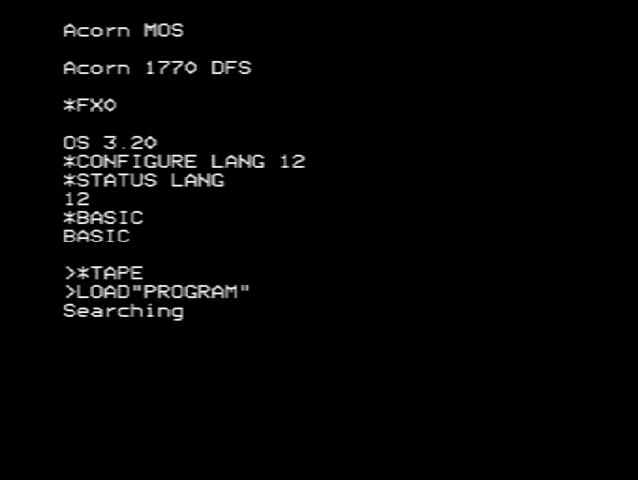
-
Amstrad CPC (1984-90) — Amstrad Disk Operating
System (AMSDOS) with
Locomotive BASIC 1.0, 4 MHz Z80A, 64 KB of RAM, built-in
datassette; 3,000,000 sold
-
Sinclair ZX Spectrum (1983-89) — PCWDOS with
Sinclair BASIC, 3.5 MHz Z80A, 16 KB of RAM; 5,000,000 sold
(1982-92) thanks to a large game library available in
cassettes; produced in the US as Timex Sinclair 2068 (Timex
2068 in the rest of the Americas) with 48 KB of RAM and a
cartridge bay
Probably due to the American market has always influenced
other countries especially English-speaking Canada, in this case,
some vendors and models did arrive at the UK.
-
Commodore 64 (1982-94)
The C64 came with KERNAL (OS) with
CBM BASIC 2.0, a MOS 6202 1.023 MHz (NTSC) or 0.985 MHz
(PAL) and 64 KB of RAM hence C64. More than 15,000,000 were
sold mostly in the US thanks to its large software library
available in ROM cartridges, floppies and cassettes,
peripherals and after-market hardware.
-
Atari 400 (1979-92)
The Atari 400 came with Atari DOS with
Atari BASIC, a MOS 6202 1.79 MHz (NTSC) or 1.77 MHz (PAL) and
8 KB of RAM upgradeable to 16 KB. About 4,000,000 sold thanks
to its large software library available in 8 KB ROM
cartridges.
-
Tandy Color Computer (1980-91)
The TRS-80 Color Computer (1980-83) — nicknamed
CoCo for Color Computer — came with no
DOS, but with MS
Color BASIC (CB) 1.0 (1980) to 1.3 (1982), a 0.89 MHz
Motorola MC6809E and 4 or 16 (later discontinued) or 64 KB of
RAM.
The TRS-80 Color Computer 2 (1983–86) —
later renamed Tandy Color Computer 2 — came with no DOS (optional
Microware OS-9 Level II), but with MS Color BASIC 1.1 (8 KB
ROM) or MS Extended Color Basic (ECB, 1984, 16 KB ROM) or MS
Disk Extended Color BASIC (DECB, 1984) that included
management routines for disks (a heavily stripped-down
version of DOS using
the DOS
command to auto-boot software from disk as in the case
Microware OS-9 Level II with Microware BASIC09 (not BASIC
09), a 0.89 MHz Motorola MC6809E that could be
overclocked to 1.8 MHz by hacking the clock generator, 16 or
32 or 64 KB of RAM and a MC6847T1 video display generator
(VCG) allowing the CoCo to display upper and lower case
characters. The
CoCo 3 with 64 KB of RAM is the system that, if I had not
opted for the C64 in
the spring of 1984, I would have liked to own. Both systems
cost about $300 at the time.
The Tandy Color Computer 3 (1986–91) was
the last model of the CoCo line and no longer referred to as
TRS-80. It came with MS Disk Extended Color BASIC (DECB,
1984) that included routines for disk management (a
stripped-down version of DOS using the
DOS command)
or Microware OS-9 Level II with Microware BASIC09, a 0.895
MHz Hitachi 6309, 128 KB of RAM (upgradeable to 512 KB, 64 KB
dedicated to OS-9), a MC6847 video display generator (VCG)
and a MC6883 synchronous address multiplexor (SAM). The CoCo
3 can run the modern NitrOS9
instead of Microware OS-9.
In all, the CoCo line used four dialects of BASIC.
-
Color BASIC (CB) 1.0 (1980), 1.2 (c. 1981) and 1.3
(1982) by Microsoft
-
Extended Color BASIC (ECB) 1.0 (1984) by Microsoft
-
Extended Color BASIC (ECB) 2.0 (c. 1985) by Microware
after Microsoft's decision not to develop it
-
Disk Extended Color BASIC (DECB, 1984) with routines
for disk management by Microsoft
About 250,000 sold combining all CoCo models (1983–91)
thanks to a large software library available in ROM
cartridges (software packs), floppies and cassettes,
peripherals and after-market hardware. Since the CoCo as well
as its software and its peripherals were made by or solely
sold at Tandy/RadioShack, there was no need for third-party
distribution. The only problem was the decision not allowing
third-parties to develop software for the CoCo, which caused
the quality of some software not be as popular as it could
have been. In other words, sales of CoCo units could have
been ever better.
-
TRS-80 Model I (1977-81)
TRS-80 Model III — nicknamed Trash-80 — came with
TRSDOS 1.3
(optional Logical Systems'
LDOS 5 or NewDos/80) with
Level I BASIC (Steve Leininger, 1977), a 1.774 MHz Z80A and 4
KB RAM expandable to 48 KB.
-
TRS-80 Model II (1979-80)
TRS-80 Model III — nicknamed Trash-80 — came with
TRSDOS with
Microsoft Disk BASIC, 4.00 MHz Z80A and 32 ($3,450) or 64k of
RAM ($3,899).
-
TRS-80 Model III (1980-83)
TRS-80 Model III — nicknamed Trash-80 — came with
TRSDOS 1.3
(optional Logical Systems'
LDOS 5) with Level I BASIC, a 2 MHz Z80A and 4 KB RAM
expandable to 48 KB. Over 250,000 were sold thanks to a large
software library available in floppies and tapes. The TRS-80
was commonly used for work, rather than as a home computer.
As mentioned several times, I used a Model III at school.
-
TRS-80 Model IV (1983-91)
TRS-80 Model III — nicknamed Trash-80 — came with
TRSDOS 6.2 or
Logical Systems' LDOS
6.00, TRSDOS 1.3,
Logical Systems' LDOS
5.3 or Misosys LS-DOS 6.3 or
CP/M 2.2
or 3.0 with Level I or Level II BASIC (Steve Leininger),
4 MHz Zilog Z80A or 6+ MHz with Z80B/Z80H or HD64180/Z180 CPU
configurations. The Model IV was marketed to businesses with
a price of $799 for a disk-less, bare-bones system to $1999
for a double drive unit.
-
Machine with Software eXchangeability
(1983-93)
"Bill Gates demands 100% loyalty and demands being his
subordinate. I'd be very happy to work with him, but I
don't want to sell my soul to him." — Kazuhiko Nishi (Wall
Street Journal, 1986)
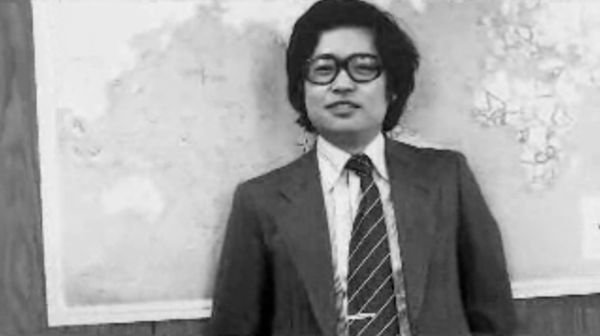
MSX was an attempt to standardize hardware so software
written for one system (for example, Toshiba) would work for
another (for example, Hitashi). It was the brainchild of
Kazuhiko Nishi (ASCII Corporation & Microsoft) and Bill Gates
(Microsoft). This meant that there was no need for choosing a
vendor from another with different architectures as software
and peripherals would work on any MSX micro. The MSX
standardization was not a hit in the United States, but Japan
was different. Right after, other markets worldwide followed
— Asia (Korea), South America (Brazil and Chile), Europe
(Netherlands, France, Spain and Finland) and the Soviet
Union.
The common MSX (worldwide, 1983) architecture was based on
a 3.58 MHz Zilog Z80A CPU, at least 8 KB of RAM (most models
shipped with 64 KB), 32 KB of ROM, a General Instrument
AY-3-8910 3-voice programmable sound generator (PSG), 16 KB
of VRAM and a Texas Instruments TMS-9918/9928/9929 video
display processor (VDP) running MSX-DOS with MSX
BASIC 1.0 (based on GW-BASIC with extensions provided by
ASCII).
The common MSX2 (worldwide, 1985) architecture was based
on a 3.58 MHz Zilog Z80A CPU, at least 64 KB of RAM, 48 KB of
ROM, a Yamaha YM2149 PSG, 64 KB of VRAM (most models shipped
with 128 KB), Yamaha V9938 VDP and a Ricoh RP5C01 real time
clock (RTC) chip with a rechargeable battery running MSX-DOS with MSX
BASIC version 2.0 or 2.1.
The common MSX2+ (Japan officially, Europe and Brazil via
upgrades, 1988) architecture was based on a 3.58 MHz Zilog
Z80A CPU (5.37 MHz via software), 64 KB of ROM, at least 64
KB of RAM, a Yamaha YM2149 PSG, at least 128 KB of VRAM, a
Yamaha V9958 VDP and a Ricoh RP5C01 RTC chip with
rechargeable battery running MSX-DOS with MSX
BASIC version 3.0.
The common MSX3 (Japan only, 1988) architecture was based
on a 3.58 MHz Zilog Z80A CPU with 256 KB or a 7.16 MHz ASCII
DAR800-X0G CPU (referred to R800, 28.6 MHz compared to the
Z80) with 512 KB, 96 KB of ROM, a Yamaha YM2149 PSG, at least
128 KB of VRAM, a Yamaha V9958 VDP and a Ricoh RP5C01 RTC
chip with rechargeable battery running MSX-DOS with MSX
BASIC version 4.0.
Computer manufacturers worked around the MSX architecture
to make themselves different from the others — more RAM, more
VRAM, better sound chips, including internal FDDs, including
internal HDDs or any other improvement that could mean better
sales.
I never knew of the MSX architecture or any of these
machines before writing about the different dialects in
BASIC. Coming from the C64 environment, I knew
that computers were obsolete as soon as they hit the shelves
and I had become fairly cynical about new technologies — not
limited to micros, mainframes and midrange computers
too. I am not sure if I would have bought one of a MSX
machines. After all, most MSX machines were not sexy at all —
nowhere near a
CoCo 3. Nowadays I might buy a MSX machine right now out
of curiosity more than anything else — some historical aspect
too.
The 8-Bit War & Me:
I remember reading lots of books on BASIC, machine language
for the C64 and a handful of
copies of BYTE magazine as well as watching TVOntario's
Bits and Bytes on WNET (1983). My experience in junior
high (middle) school was on a disk-less
TRS-80 Model III (1983-85). At home, I spent many hours in
front of my C64
connected to a B/W 13" Zenith TV writing programs that no longer
exist. Saving programs on cassettes was an unreliable yet very
common at the time because it was affordable (about $40) rather
than a floppy disk drive and interface cables for about $250.
I never got a chance to play with an
Atari, a
ZX, a
Amstrad CPC, a
CoCo or any other 8-bit home computer other than my C64.
Maybe this is why I have a fascination with 8-bit computers
specially the
CoCo 3.
Maybe any 8-bit home computer system back then would have been
the same to me, but my first experience with computers was my C64
— not merely a few hours a week in shop class on a
TRS-80 Model III. This is why, on this page, I can only
concentrate on my experience of BASIC on my C64.
Commodore 64 & BASIC 2.0:
The C64 was one of the first computer systems that I ever used
and the first one I ever owned (spring 1984). I quickly got up
hooked into a whole new field and style of life —
geekdom — and coding into late hours of the night
instead of sleeping. The experience of working with KERNAL (the OS), machine language
(accessing KERNAL) and Commodore BASIC
(programming) in its 8-bit glory boasting a 1.023 MHz MOS CPU
Technology 6510 microprocessor and 64 KB of RAM was as fun as it
could be for any kid in the early 1980s. To make things even more
exciting and bringing more curious kids (like me at the time) to
computer science, the C64 was heavily used for games and even
some music programs thanks to its ground-breaking technology
based on two chips by MOS Technology — SIC 6581 and VIC-II.
Commodore International declared bankruptcy and closed shop in
1994.
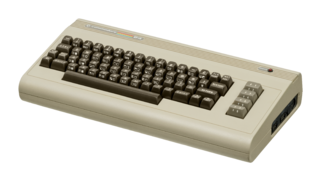
In 2011, Commodore USA, LLC, took over the Commodore brand
name and released updated versions of the C64 (C64x) with the
same vintage (old, obsolete, ancient, historical, retro)
"breadbox" exterior and VIC 20 (VIC Slim) with their own Linux distribution named Commodore OS. I had
not been thrilled about any new system and/or other technologies
for a long time. The whole idea of reviving the C64x had me like
a little kid before Christmas with a new toy wrapped in front of
him, but I never bought one. Commodore USA closed shop a little
after one of its owners died in 2013.
In 2015, Commodore Business Machines Ltd (UK) took over the
brand name and marketed mobile phones with the C64 look and feel
rather than the classic C64 "breadbox" body.
In 2018, Retro Games Ltd (UK) took over the rights to relive
the heyday of the C64 (1982-85) with The C64 MINI
marketed as a video game console with 64 built-in games and
shipped with its own joystick, THEC64 like the previous
but with a working keyboard as well as a stand-alone joystick
named THEC64 Micro Switch Joystick. The company has also
released new version of the VIC20. All these machines, except for
the stand-alone joystick, can also be used to program Commodore
BASIC (forked from Microsoft BASIC) — the first programming
language that I ever learned. If there was ever a computer I was
excited about its launch, I would say it is the C64. I want to
get my hands on the new the C64, but first I want to make sure
the new Commodore company will last. Needless to say, I am
stoked.
10 INPUT "WHAT'S YOUR NAME? "; NAME$
20 PRINT "HELLO, "; NAME$;
30 INPUT ", HOW ARE YOU? (OK/NOT)" ; OK$
40 IF OK$ = "OK" THEN PRINT "GLAD TO HEAR THAT, "; NAME$; "!"
50 IF OK$ <> "OK" THEN PRINT "TOO BAD, "; NAME$; "! BETTER LUCK NEXT TIME!"
Another nostalgia option was Manomio's licensed emulator for
iOS — iPhone, iPod and iPad. This emulator was almost as
good as the original the C64, but it was removed from the market
without notice. I think someone might have considered it some
sort of copyright violation.
Unfortunately, it has been over three (3) decades since I last
coded my last program for the C64 and I can hardly remember how
to code a quick and dirty (not to mention descent) program
(excluding the one above — OKAY.BAS), but I would
consider it the geekiest purchase I would ever make.
Of course, if you are merely interested in C64 games, you can
get a ROM emulator and a handful of ROM images, which 05/be
illegal in some areas and/or under special conditions as
explained in
17 U.S.C. § 117(a).
§ 117 . Limitations on exclusive rights: Computer
programs
(a) Making of Additional Copy or Adaptation by Owner of
Copy.—Notwithstanding the provisions of
section 106, it is not an infringement for the owner of a
copy of a computer program to make or authorize the making of
another copy or adaptation of that computer program
provided:
(1) that such a new copy or adaptation is created as an
essential step in the utilization of the computer program in
conjunction with a machine and that it is used in no other
manner, or
(2) that such new copy or adaptation is for archival purposes
only and that all archival copies are destroyed in the event
that continued possession of the computer program should cease
to be rightful.
In 1990 or 1991, Commodore came up with a prototypes
for the Commodore 65 (probably just a prototype name). Being a
prototype, only few units exist and one of these units could
easily sell in an auction for close to 47,000€ (about $49,500).
The C65 boasted a 3.54 MHz 16-bit CSG 4510 CPU (compared to the 1
MHz CPU in C64) combined with two MOS 6526 chips, Universal
Asynchronous Receiver/Transmitter (UART) serial interface, 1 MB
of RAM mapping (depending on RAM expansion), a VIC-III graphics
chip (256 colors, 40/80×25 text), CSG 8580R5 SID chips capable of
independent outputs (stereo), 128 KB of RAM built-in (1 MB
maximum via an expansion port), CBM-BASIC 10.0 (not version 2.0
as in the C64) and built-in 3.5" double-sided disk density (DSDD)
floppy disk drive accessible via DOS (not the
controller for the external floppy disk drive as in the C64).
The Museum of Electronic Games & Art (MEGA,
Germany) is producing the MEGA65 with a 40.5 MHz 8-bit GS4510 CPU
(about the same speed as an i486 though not sure of the vendor of
the new CPU), 384 KB of fast RAM (old CBM hardware) and 8 MB of
Hyper-RAM (hypervisor), four soft-SIDs and two 8-bit DACs
(digital-to-analog converters), MEGA OS (hypervisor to run
multiple VMs: BASIC 10 or BASIC 65
GEOS 64 or Contiki) on a VFAT32 formatted SD. The latter
comes as a DevKit (development kit; in other words, parts for the
user to build) of the C65 for
666.66€ or 793.33€ gross (about $705 or $835 gross). Maybe the
MEGA65 is sold as a kit to lower costs or to avoid legalities. In
either case, this kit is for anyone with a background in
computers and programming including assembly. It seems that the
only difference between the MEGA65 and the original C64 is the
ability to access SD cards (disk images including KERNAL and the BASIC ROM files)
rather than only 3.5" floppies and the introduction of Computer Based Disk
Operating System (CBDOS) and BASIC 10
(just like the C65
prototype) and BASIC 65. This means that the MEGA65 can run in
three different modes — BASIC 2.0 (C64.ROM), BASIC 10
(C65.ROM) and BASIC 65 (MEGA65.ROM).
Note that, since the MEGA65 is made in Germany, the output
might be PAL (50 Hz AC, 625 lines, 50 fields, 25 fps) and might
not work on NTSC (60 Hz AC 625 lines, 60 fields, 30 fps). I could
not find this in the system specifications (specs). If you have a
dual mode monitor, you should be okay.
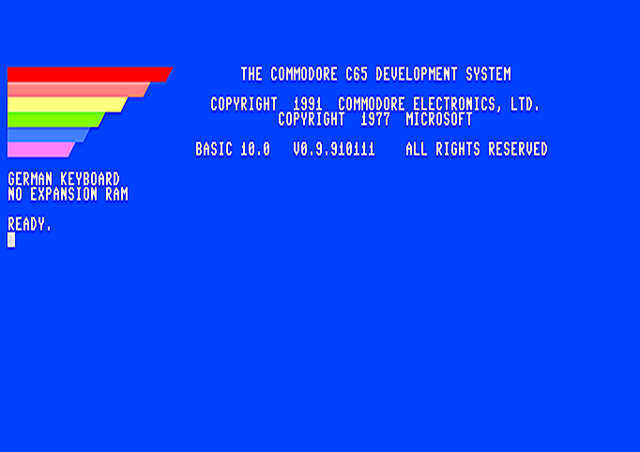
TRS-80:
As I mentioned before, I also have a special memory of the
TRS-80, specially Model III and the Color Computer 3 (CoCo 3) —
not other models of the TRS-80 family. I used a TRS-80 at school
(two students per machine). I enjoyed annoying others with the
orange button on the top right hand side of the keyboard — memory
flush, similar to the NEW command in BASIC (Level I
BASIC, in this case).
.jpg)
I never used a
CoCo 3, but I remember seeing it in Radio Shack stores and
thinking that it was a sexy machine. As a matter of fact, the
CoCo 3 remains as one of the sexiest computers ever made.
![By Lamune (Talk) — Copyed from English Wikipedia Tandycoco2.jpg], Copyrighted free use, https://commons.wikimedia.org/w/index.php?curid=460962 By Lamune (Talk) — Copyed from English Wikipedia Tandycoco2.jpg], Copyrighted free use, https://commons.wikimedia.org/w/index.php?curid=460962](/img/320px-TRS-80_Color_Computer_2-64K.jpg)
Other Versions of BASIC:
There are many versions (dialects) of BASIC. The following is
a quick list of interpreters in chronological order.
-
Microsoft BASIC originally released as Altair BASIC for
Altair 8800 (1975)
-
Integer BASIC (Apple BASIC) for Apple I and Apple II
(1977)
-
Commodore BASIC (PET BASIC or CBM-BASIC) from PET
(ver. 1.0, 1977) to C128 (ver. 7.0, 1985) — the dialect that
got started as a programmer in spring 1984 on the C64 running version
2.0
-
Color BASIC for TRS-80 CoCo (1980-91)
-
BASIC Programming ROM cartridge (Warren Robinett, 1979),
replaced with Atari Microsoft BASIC for Atari 8-bit home
computers sold on floppy and ROM cartridge under the name
Atari Microsoft BASIC II (Microsoft, 1981-92) IBM BASIC
available as Cassette BASIC, Disk BASIC and Advanced BASIC
(BASICA) for IBM 5150 (1981) and Cartridge BASIC for IBM PCjr
(1984)
-
Modern versions of BASIC
-
Visual Basic (Microsoft, 1991) for Windows only
-
Liberty BASIC (Carl Gundel, Shoptalk
Systems, 1992), followed by Run BASIC (2008) that is a
web application server running the Liberty BASIC and
SQLite versions released that year — only release, no
updates
-
Gambas (Benoît Minisini, 1999) for
Unix-like environments
only
-
Visual Basic .NET, also referred to as
VB.NET (Microsoft, 2001) for Windows only
-
FreeBASIC (Andre Victor, FreeBASIC
Development Team, 2004)
-
Mono (Miguel de Icaza under Ximian, then
.NET Foundation and Xamarin, 2004) to port VB.NET to
Linux
-
Small Basic (Microsoft, 2008) for
Windows only
-
SmileBasic (SmileBoom Co. Ltd, 2011)
for children to program games for the Nintendo 3DS
console
-
True Basic (John Kemény, Thomas Kurtz,
1983) made by the authors of the "original"
BASIC at Dartmouth College (1964), for Windows and macOS
-
TinyBasic (Tom Pittman, 1976) made as a
result of "a lot of whining about Bill Gates charging
$150 for his Basic interpreter" (Jul 2004)
-
Xojo (Xojo, 2020)
Installing BASIC:
BASIC on i286 and prior machines came burnt to a ROM chip.
There is no way users could install BASIC other than changing the
ROM chips. On boot, it loads from the built-in ROM to RAM. Later
machines would run DOS
and have BASIC as a stand-alone executable like
QBASIC.EXE (Microsoft BASIC), but by no means being the
similar instruction set of the late 1970s or 1980s.
Nowadays there are newer versions of BASIC that are installed
as any other program would be on a computer via an executable or
script. For example, FreeBASIC is available for DOS, Windows and Linux.
No More BASIC, 16-Bit Microcomputers:
When 16-bit computers became mainstream in the late 1980s,
BASIC was no longer intertwined with the OS and programming no
longer was the main purpose of computers. In most OSs, BASIC was
just reduced as a stand-alone binary like GW-BASIC (numbering
each line, Microsoft, 1983-88) or QBasic (structured programming,
Microsoft, 1991-present). Slowly BASIC was removed from OS
distributions like Windows.
The BASIC Love Affair with 8-Bit Micros:
Most nerds (myself included) who grew up with micros
(1977-95) love these machines. More than nostalgia, it is a love
affair or even a sub-culture (cult, as in cultural).
This is the reason why there is a whole market of second-hand
8-bit micros and modern hardware that can be connected
to the old hardware like HDDs and FDD emulators, hardware
replacement and upgrades to bypass the original like sound and
video cards, wireless adapters, PAL to NTSC converters and such.
As a matter of fact, Tandy/RadioShack, Commodore, Atari, Acorn
and Sinclair micros (including non-licensed USSR clones)
are some of the best selling units in the second-hand market
(eBay, etc.) with prices ranging from $100 to $500 bare-bones.
Even 16-bit micros like the line of Commodore Amiga can
easily sell from $200 to $1,000. Software, original monitors and
peripherals can also demand high prices depending on manufacturer
and rarity. Brand new (never open, often referred to a new old
stock) vintage machines can sell for thousands. Of course, these
prices are usually for mass-produced micros. Prototypes like
C65 can demand 47,000€
(about $49,500) in auction.
Z80 & SymbOS:
Most 8-bit micros ran on the Zilog Z80 CPU
architecture, which hit the market in 1976. In 2006, German
developer Jörn "Prodatron" Mika released SymbOS. The latter is a
multitasking OS that runs on Z80 chips as replacement to the
built-in OS of a given computer with a GUI similar to Windows 95 written in
assembly.
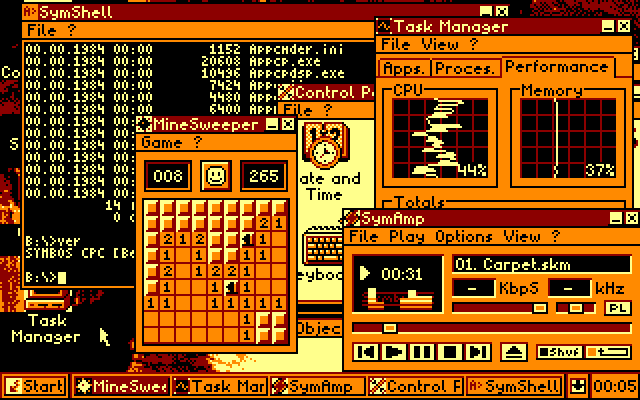
.jpg)





.jpg)
![By Lamune (Talk) — Copyed from English Wikipedia Tandycoco2.jpg], Copyrighted free use, https://commons.wikimedia.org/w/index.php?curid=460962 By Lamune (Talk) — Copyed from English Wikipedia Tandycoco2.jpg], Copyrighted free use, https://commons.wikimedia.org/w/index.php?curid=460962](/img/320px-TRS-80_Color_Computer_2-64K.jpg)
